Centauri Dreams
Imagining and Planning Interstellar Exploration
New Horizons Countdown
We’re under the 24 hour mark for the Pluto flyby. NASA will offer a news briefing for New Horizons (check NASA TV), covering mission status and what to expect during flyby, at 1030 EDT (1430 UTC) today, a schedule change that moves the time up by half an hour. On Tuesday morning, the agency will present a live program called Arrival at Pluto Countdown starting at 0730 (1130 UTC). Remember that closest approach to Pluto is scheduled to occur at approximately 0749 (1149 UTC) on Tuesday, when the spacecraft comes within 12,500 kilometers of the surface. Gathering data, the spacecraft will be out of communication for much of that day.
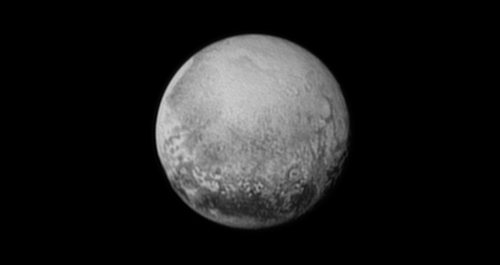
Image: Pluto as seen from New Horizons on July 11, 2015. Credit: NASA/JHUAPL/SWRI
You can check NASA’s television coverage and media activities here, but I’ll also send you to Emily Lakdawalla’s page at The Planetary Society, where the indefatigable reporter has gathered in one place everything known about the schedule and other sources of information. Lakdawalla also offers a list of all the planned downlinks of image data during close approach. It’s interesting to see that Pluto will appear larger than the LORRI (Long-Range Reconnaissance Imager) field of view for less than 24 hours during the close approach.
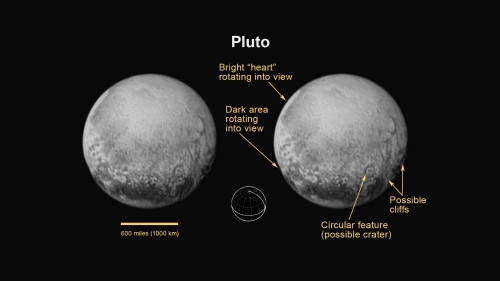
Image: On July 11, 2015, New Horizons captured a world that is growing more fascinating by the day. For the first time on Pluto, this view reveals linear features that may be cliffs, as well as a circular feature that could be an impact crater. Rotating into view is the bright heart-shaped feature that will be seen in more detail during New Horizons’ closest approach on July 14. The annotated version includes a diagram indicating Pluto’s north pole, equator, and central meridian. Credit: NASA/JHUAPL/SWRI
What we’ll all be waiting for with no little degree of tension is the downlink scheduled for the night of July 14, which will demonstrate that after its period of intense data-taking, New Horizons has survived the encounter and will be able to transmit stored data back to Earth. Assuming that all goes well, NASA has scheduled release of close-up images for the media briefing at 1500 (1900 UTC) on July 15.
Here is what happens next, as described by Emily Lakdawalla:
Following closest approach, on Wednesday and Thursday, July 15 and 16, there will be a series of “First Look” downlinks containing a sampling of key science data. Another batch of data will arrive in the “Early High Priority” downlinks over the subsequent weekend, July 17-20. Then there will be a hiatus of 8 weeks before New Horizons turns to systematically downlinking all its data. Almost all image data returned during the week around closest approach will be lossily compressed — they will show JPEG compression artifacts. Only the optical navigation images are losslessly compressed.
Data transmission takes quite a while, with the entire dataset (lossily compressed) being downlinked starting in mid-September and continuing over a ten week period. In November, the spacecraft will downlink the entire science data set compressed without loss, a process that will take a year to complete. We’ll be keeping up with New Horizons for a long time, and here’s hoping that will include a KBO encounter and an upload of the One Earth Message.
Off on a Comet
And let’s not forget Comet 67P/Churyumov-Gerasimenko, which for over a year now has been under study by the European Space Agency’s Rosetta spacecraft. We’re now one month away from perihelion for the comet, the point at which the comet is closest to the Sun in its orbit, and therefore likely to show the greatest amount of surface activity. When Rosetta reached the comet, both were 540 million kilometers from the Sun. That distance has now closed to 195 million kilometers, and will reach 186 million km by the 13th of August.
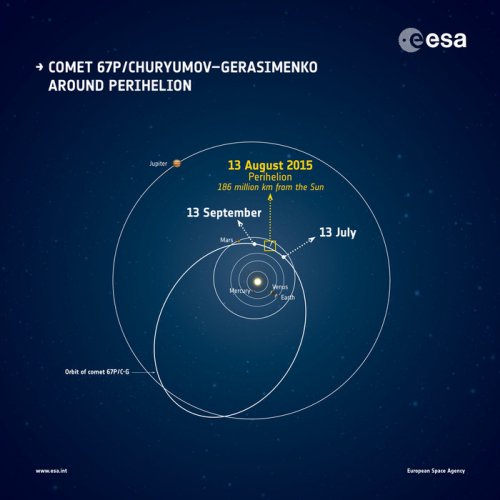
Image: The orbit of Comet 67P/Churyumov-Gerasimenko and its approximate location around perihelion, the closest the comet gets to the Sun. The positions of the planets are correct for 13 August 2015. Credit: ESA.
“Perihelion is an important milestone in any comet’s calendar, and even more so for the Rosetta mission because this will be the first time a spacecraft has been following a comet from close quarters as it moves through this phase of its journey around the Solar System,” notes Matt Taylor, ESA’s Rosetta project scientist.
“We’re looking forward to reaching perihelion, after which we’ll be continuing to monitor how the comet’s nucleus, activity and plasma environment changes in the year after, as part of our long-term studies.”
This ESA news release has more about Rosetta’s progress. Post-Pluto/Charon, we have a summer full of fascinating science ahead with Rosetta and, of course, Dawn’s continuing work at Ceres. But first let’s get New Horizons through that flyby.

Charon: A Rugged, Cratered Surface
A chasm in Charon’s southern hemisphere turns out to be longer and deeper than Earth’s Grand Canyon, says William McKinnon (Washington University, St. Louis), deputy lead scientist with New Horizon’s Geology and Geophysics investigation team.
“This is the first clear evidence of faulting and surface disruption on Charon. New Horizons has transformed our view of this distant moon from a nearly featureless ball of ice to a world displaying all kinds of geologic activity.”

Image: Chasms, craters, and a dark north polar region are revealed in this image of Pluto’s largest moon Charon taken by New Horizons on July 11, 2015. Credit: NASA/JHUAPL/SWRI.
The most prominent crater, near Charon’s south pole, is almost 100 kilometers across, and evidently the result of a geologically recent impact. This NASA news release adds that the darkness of the crater floor may be the result of a different kind of icy material being exposed, less reflective than the ices on the surface. Another possibility: The ice of the crater floor has a larger grain size, reflecting less sunlight. This would be the result of ice melting during the impact event and re-freezing into larger grains.
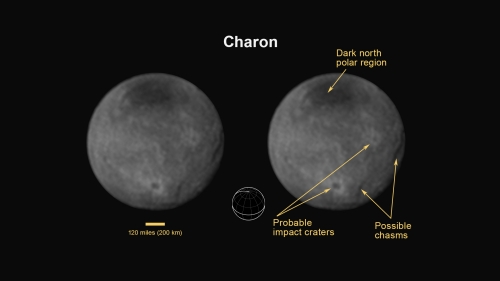
Image: This annotated version of the Charon imagery includes a diagram showing Charon’s north pole, equator, and central meridian, with the features highlighted. Credit: NASA/JHUAPL/SWRI.
Meanwhile, the dark region near Charon’s north pole bears watching, with more detailed images coming up on the 14th.

Last Look at Pluto’s ‘Far Side’
The side of Pluto that always faces its large moon Charon is the side that New Horizons won’t see when it makes its close flyby on July 14. That makes the image below what principal investigator Alan Stern is calling “the last, best look that anyone will have of Pluto’s far side for decades to come.”
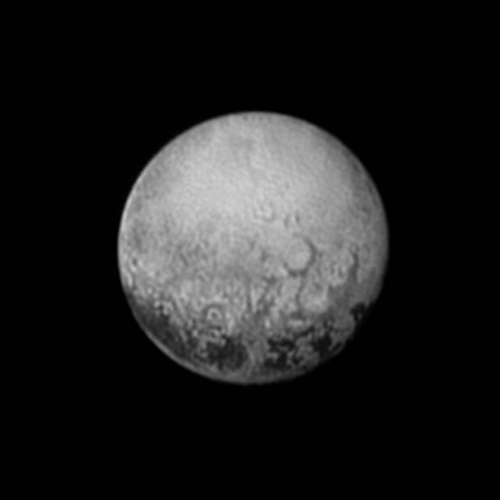
Image: New Horizons’ last look at Pluto’s Charon-facing hemisphere reveals intriguing geologic details that are of keen interest to mission scientists. This image, taken early the morning of July 11, 2015, shows newly-resolved linear features above the equatorial region that intersect, suggestive of polygonal shapes. This image was captured when the spacecraft was 2.5 million miles (4 million kilometers) from Pluto. Credit: NASA/Johns Hopkins University Applied Physics Laboratory/Southwest Research Institute.
Four dark spots seem to be connected to the dark belt in Pluto’s equatorial region, their fairly regular spacing a source of considerable curiosity. The large areas are estimated to be roughly 480 kilometers across, with irregular boundaries between light and dark terrain. Jeff Moore (NASA Ames) gives a glimpse of what’s ahead:
“When we combine images like this of the far side with composition and color data the spacecraft has already acquired but not yet sent to Earth, we expect to be able to read the history of this face of Pluto.”
And of course, as this JHU/APL news release reminds us, we’ll soon be seeing the encounter hemisphere from as close as 12,500 kilometers.

New Horizons: Detecting Geology
Pluto’s surface is beginning to be revealed, with the first signs of geological features, as principal investigator Alan Stern explains:
“Among the structures tentatively identified in this new image are what appear to be polygonal features; a complex band of terrain stretching east-northeast across the planet, approximately 1,000 miles long; and a complex region where bright terrains meet the dark terrains of the whale. After nine and a half years in flight, Pluto is well worth the wait.”
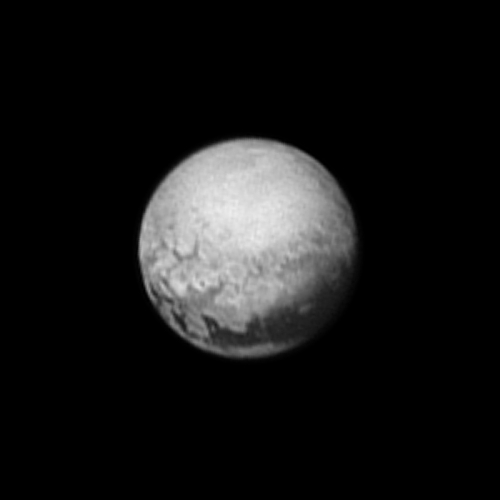
Image: Tantalizing signs of geology on Pluto are revealed in this image from New Horizons taken on July 9, 2015 from 3.3 million miles (5.4 million kilometers) away. At this range, Pluto is beginning to reveal the first signs of discrete geologic features. This image views the side of Pluto that always faces its largest moon, Charon, and includes the so-called “tail” of the dark whale-shaped feature along its equator. (The immense, bright feature shaped like a heart had rotated from view when this image was captured. Among the structures tentatively identified in this new image are what appear to be polygonal features; a complex band of terrain stretching east-northeast across the planet, approximately 1,000 miles long; and a complex region where bright terrains meet the dark terrains of the whale. Credit: NASA/Johns Hopkins University Applied Physics Laboratory/Southwest Research Institute.
The annotated image below includes a reference globe showing Pluto’s orientation, with equator and central meridian in bold.
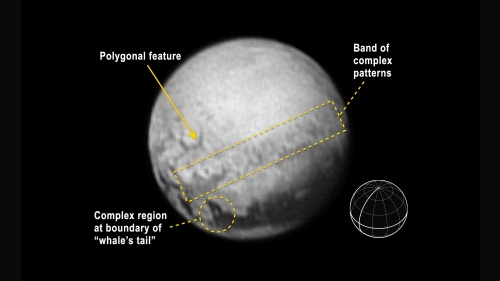
And the photo below speaks for itself. It’s been nine years. Pluto at last.
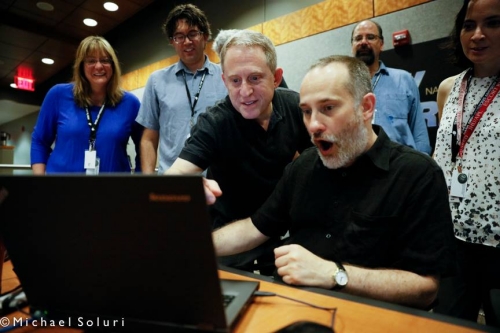
Image: Science team members react to the latest New Horizons data from Pluto at the Johns Hopkins University Applied Physics Lab on July 10, 2015. Left to right: Cathy Olkin, Jason Cook, Alan Stern, Will Grundy, Casey Lisse, and Carly Howett. Photo by Michael Soluri.

New Horizons: Flyby Schedule, Images
New Horizons makes its closest approach to Pluto, at approximately 12,500 kilometers above the surface, at 0749 EDT (1149 UTC) on Tuesday July 14. Be aware that for much of that day, we’ll be out of communication with the spacecraft while it’s busy gathering data. About 2102 EDT (0102 UTC on the 15th), we should receive a confirmation of a successful flyby — the spacecraft is scheduled to send a preprogrammed signal that it has survived the close approach. Then the data flow begins and will continue for months.
NASA offers the schedule for the flyby here, with information on NASA TV coverage. We should be looking at close-up images of Pluto and hearing early reactions from the science team by mid-afternoon of Wednesday the 15th. And of course it will be possible to follow the mission on Facebook or on Twitter (also #PlutoFlyby). The nail-biting time will be the wait on the 14th for the signal announcing a successful transit of the system. It doesn’t take a large object to silence a spacecraft moving at 14 kilometers per second and we can only hope for the best.


Meanwhile, the imagery keeps improving, with both Pluto and Charon beginning to swim out of the image-processing mist. We’re seeing bright and dark features on Pluto’s surface, while Charon presents a more uniform light gray terrain with a large dark polar region. This NASA news release speculates on the possibility of impact craters on Charon, quoting Jeff Moore (NASA Ames): “If we see impact craters on Charon, it will help us see what’s hidden beneath the surface. Large craters can excavate material from several miles down and reveal the composition of the interior.”
Image: Pluto from the New Horizons’ Long Range Reconnaissance Imager (LORRI), July 8, 2015. Most of the bright features around Pluto’s edge are a result of image processing, but the bright sliver below the dark “whale,” which is also visible in unprocessed images, is real.
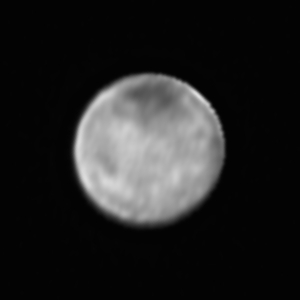
The differences between Pluto and Charon are increasingly apparent, with Charon lacking the reddish color of the former, a hue that has reminded some of us of early, blurry photos of Mars. While frozen ices like nitrogen, carbon dioxide and methane have been detected on Pluto, Charon’s surface seems to be mostly frozen water and ammonia compounds. Unlike Pluto, Charon has no atmosphere, and its interior is composed of rock and ice in equal measures, whereas Pluto’s interior is predominantly rock. The lower surface contrast of Charon has been abundantly clear as New Horizons returns images of the two dissimilar worlds.
Image: Image of Charon from the New Horizons’ Long Range Reconnaissance Imager (LORRI), July 8, 2015. Credit: NASA/Johns Hopkins University Applied Physics Laboratory/Southwest Research Institute.
As New Horizons nears its closest approach, the Cassini orbiter will take images of Pluto/Charon from its distant station around Saturn, and beginning July 23, the Spitzer Space Telescope will take seven days of observations at infrared wavelengths. The plan is to study ices on Pluto’s surface. New Horizons will also be backed up by Kepler observations, with the K2 mission focusing on Pluto for a three month period beginning in October.
“K2 observations will expand the time coverage of the speedy New Horizons flyby of Pluto, making observations of the dwarf planet-moon system every 30 minutes,” said Steve Howell, project scientist for Kepler/K2 at NASA’s Ames Research Center in Moffett Field, California. “We are excited to turn the planet-hunting Kepler spacecraft’s attention to this distant solar system object to provide additional scientific insight into this far-off, mysterious world, itself a miniature solar system of five moons in orbit about Pluto.”
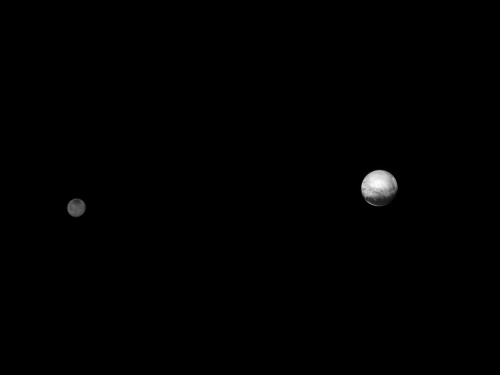
Image: New Horizons was about 3.7 million miles (6 million kilometers) from Pluto and Charon when it snapped this portrait late on July 8, 2015. Credit: NASA/Johns Hopkins University Applied Physics Laboratory/Southwest Research Institute.
And we’ve already had one interesting study performed by the SOFIA airborne observatory, an infrared telescope mounted on a 747 aircraft. On June 28, Pluto occulted a distant star, creating a backlighting that could be studied to provide a baseline measurement of Pluto’s atmosphere. All of this, plus the data that the Hubble Space Telescope has gathered about Pluto’s smaller moons, will provide datasets that complement the abundant science return of New Horizons.
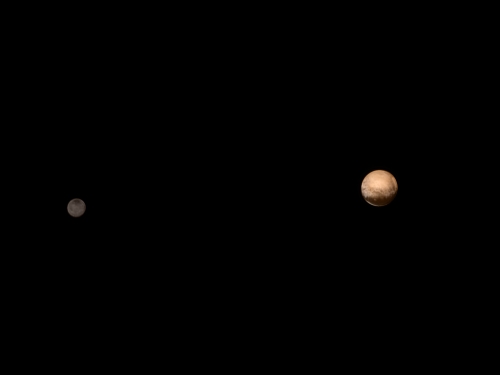
Image: This is the same image of Pluto and Charon from July 8, 2015; color information obtained earlier in the mission from the Ralph instrument has been added. Credit: NASA/Johns Hopkins University Applied Physics Laboratory/Southwest Research Institute.

Detection of Pebbles in a Circumstellar Disk
Not long ago we looked at a new paper from Alan Boss that modeled interactions in young protoplanetary disks (A Disruptive Pathway for Planet Formation). The idea here is that as dust grains and larger objects bump into each other on the way to forming planetesimals, a mechanism must exist to keep them from spiraling into their star. Boss’ models show explosive phases in young stars that lead to gravitational instabilities of the sort needed to scatter these small objects outward and preserve their prospects for forming into planetesimals, and perhaps one day, planets.
Watching infant solar systems form is akin to studying embryology in animal species, a chance to understand the myriad interactions that affect growth and set it in particular directions. Now we have work out of the University of St. Andrews, recently presented at the National Astronomy Meeting in Llandudno, Wales, that announces the discovery of a ring of small rocks circling the star DG Tauri, a 2.5 million year old object some 450 light years from Earth.
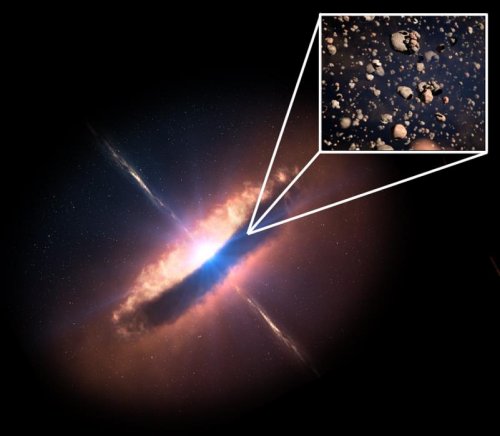
Image: An artist’s impression of the belt of ‘pebbles’ in orbit around the star DG Tauri. The inset is a close up view of a section of the belt. Credit: J. Ilee. Adapted from original work by ESO/L. Calçada/M. Kornmesser, ALMA (ESO/NAOJ/NRAO)/L. Calçada (ESO).
The work of Jane Greaves and Anita Richards (University of Manchester) is based on data from the e-MERLIN array of radio telescopes centered in Jodrell Bank (Cheshire) and extending over southern England to form an interferometer, giving it the resolution of a single large telescope. The instrumentation proved up to the considerable challenge, as Greaves relates:
“The extraordinarily fine detail we can see with the e-MERLIN telescopes was the key to this discovery. We could zoom into a region as small as the orbit of Jupiter would be in the Solar System. We found a belt of pebbles strung along a very similar orbit – just where they are needed if a planet is to grow in the next few million years. Although we thought this was how planets must get started, it’s very exciting to actually see the process in action!”
The observations, as this Royal Astronomical Society news release explains, were made at a wavelength of about 4.6 cm. They revealed a signature that requires chunks of rock at least a centimeter in size. This is a useful finding, for as we’ve seen in the work of Alan Boss, we’re in the process of tuning up our computer models of protoplanetary disks and their interactions. Now we can identify, at least in some systems, the location of pebble-like material that will one day accrete into larger objects. A deeper analysis of young disks should emerge from all this.
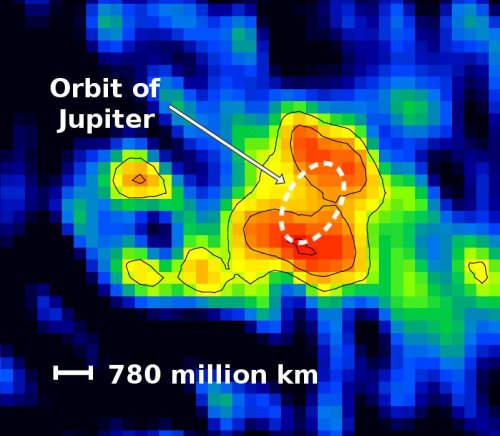
Image: An e-MERLIN map of the star DG Tauri. The yellow and red areas show what is thought to be a ring of pebble-sized clumps in orbit around the star. Credit: J. Greaves / A. Richards / JCBA.
Studying the results will be, among others, a group called the Planet Earth Building Blocks Legacy e-MERLIN Survey (known by its fitting acronym — PEBBLeS). The team plans to extend studies like this to a number of stars that are in the process of forming their own solar systems. Right now we’re using equipment sensitive to regions as small as Jupiter’s orbit, but the logical goal is to move in five times closer to witness the formation of planets like our own. The researchers believe that upgrades to e-MERLIN and the coming capabilities of the Square Kilometer Array will make such observations possible.


